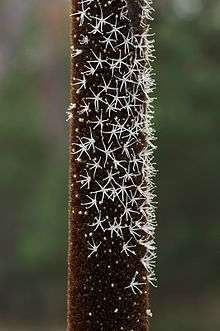Xanthorrhoea australis
| Xanthorrhoea australis | |
|---|---|
 | |
| Xanthorrhoea australis flowers after a fire in The Grampians, Victoria, Australia | |
| Scientific classification | |
| Kingdom: | Plantae |
| Clade: | Angiosperms |
| Clade: | Monocots |
| Order: | Asparagales |
| Family: | Asphodelaceae |
| Subfamily: | Xanthorrhoeoideae |
| Genus: | Xanthorrhoea |
| Species: | X. australis |
| Binomial name | |
| Xanthorrhoea australis R. Br. | |
Xanthorrhoea australis, the Grass-tree or Black Boy is an Australian plant. It is the most commonly seen species of the genus Xanthorrhoea. Its trunk can grow up to several metres tall and is often branched. In certain Aboriginal languages, it is called 'Bukkup' or 'Kawee'.
In Xanthorrhoeas, the main way to identify them is by looking at the cross-section of the leaves. In the case of the X. australis, the cross-section is a rough diamond shape, and the colour of the leaves is a bluish-green.
X. australis takes several years to flower, and it does not always flower annually, but in the season after a bushfire it flowers prolifically. The flowers appear on a spear-like spike which can grow up to 2 m tall. The flowers, with 6 petals, usually cover 1⁄2– 5⁄6 of the stem.
The crown of leaves of X. australis will be almost spherical in shape, the point of each leaf perfectly marking the shape of the imagined sphere.
X. australis has leaves which are softer and generally less rigid than other Xanthorrhoeas. Old leaves hang down forming a distinctive skirt-like feature that partly covers the fire-blackened trunk. X. australis flowers from July to December, but younger plants may flower in June. This species can also be found in South Australia, New South Wales and Tasmania.
References
- Australian Native Plants Society (Australia) (ANPSA)
- Australian postage stamp featuring X. australis
External links
- Images